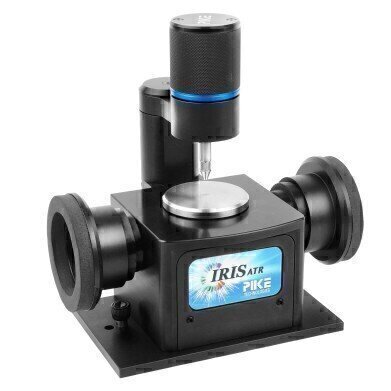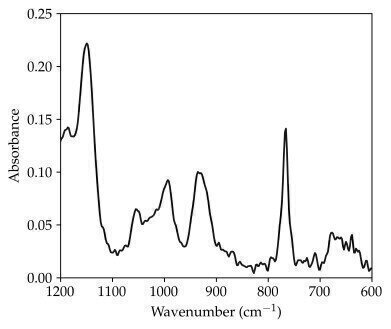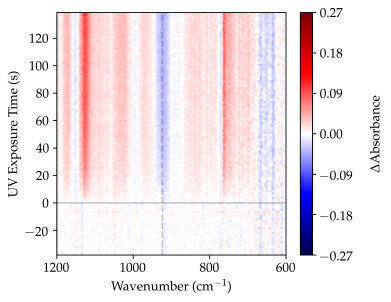-
 Figure 1. IRIS Monolithic Diamond ATR
Figure 1. IRIS Monolithic Diamond ATR -
 Figure 2. Absorbance spectrum of NOA-61 UV-cured adhesive, prior to photocuring.
Figure 2. Absorbance spectrum of NOA-61 UV-cured adhesive, prior to photocuring. -
 Figure 3. ΔAbsorbance ATR spectra of the NOA-61 epoxy during UV-lamp exposure, collected with the IRIS Monolithic Diamond ATR with the horizontal gray line denoting the initial UV lamp exposure and the dashed vertical gray line denoting the 924 cm-1 spectral band of the terminal alkene =CH2 bend.
Figure 3. ΔAbsorbance ATR spectra of the NOA-61 epoxy during UV-lamp exposure, collected with the IRIS Monolithic Diamond ATR with the horizontal gray line denoting the initial UV lamp exposure and the dashed vertical gray line denoting the 924 cm-1 spectral band of the terminal alkene =CH2 bend.
Laboratory Products
Time-Resolved ATR of a Photopolymerization Reaction
Nov 08 2019
Abstract
The photopolymerization curing process of a UV-curable polymer was investigated using time-resolved Attenuated Total Reflection (ATR) spectroscopy. Spectral band shifts and absorbance changes resulting from of UV lamp exposure were analysed to describe the chemical changes occurring during this reaction.
Introduction
ATR spectroscopy is a powerful tool for understanding the chemical structure of samples. Although ATR is most frequently used to analyze equilibrium chemical systems, it can also be used to analyse non-equilibrium systems, such as chemical reactions. Here we use the IRIS Monolithic Diamond ATR to study the spectral band evolution of a common UV-curing adhesive.
A typical reaction leading to photopolymerization is the radicalization of a thiol via absorption of an ultraviolet photon. The unstable radical then rapidly forms a bond with the terminal alkene group of a conjugated monomer, which forms another radical, thus propagating the polymerization reaction.
Experimental Methods
The photopolymer investigated was a popular UV-curing epoxy, Norland Optical Adhesive-61 (NOA-61). To observe the spectral changes during the photopolymerization reaction, time-resolved ATR spectra were collected at 1.67 s intervals. Spectra were collected on a commercial FTIR spectrometer, equipped with a DTGS detector and IRIS diamond ATR (PIKE Technologies, Madison, WI). The spectral resolution was 4 cm-1 and 1 scan per time interval was used to ensure maximum possible time resolution.
An ultraviolet lamp emitting 365 nm light was used to initiate the photopolymerization reaction, 38 seconds after the start of the time-resolved ATR measurement.
Results
The ATR spectrum of the monomer, prior to exposure with the UV lamp is shown in Figure 2. The spectral band evolution of the adhesive before and during photocuring is shown as a time, wavenumber, ΔAbsorbance contour plot in Figure 3, emphasising the multidimensionality of the time-resolved dataset and the temporal progression of the photopolymerization reaction.
A series of spectral band shape changes occur across the 600-1200 cm-1 spectral region, as shown in Figure 3. Notably a negative ΔAbsorbance feature appears near 924 cm-1, consistent with a reduction in the out-of-plane bending of the =CH2 groups common in photoinitiators prior to curing.
Conclusion
The IRIS Monolithic Diamond ATR accessory provides high optical throughput from over the spectral region of critical absorbing species present in photopolymers. By performing a time-resolved ATR investigation of a photopolymerization reaction, the spectral lineshape changes of a photopolymer before during and after the photocuring process can be quantitated. Given the high optical performance of the IRIS, combined with robust and inert physical properties of its monolithic diamond ATR crystal, the IRIS is a highly capable ATR accessory for performing analyses of equilibrium and non-equilibrium chemical species.
Digital Edition
ILM 49.5 July
July 2024
Chromatography Articles - Understanding PFAS: Analysis and Implications Mass Spectrometry & Spectroscopy Articles - MS detection of Alzheimer’s blood-based biomarkers LIMS - Essent...
View all digital editions
Events
Jul 28 2024 San Diego, CA USA
Jul 30 2024 Jakarta, Indonesia
Jul 31 2024 Chengdu, China
ACS National Meeting - Fall 2024
Aug 18 2024 Denver, CO, USA
Aug 25 2024 Copenhagen, Denmark
-(1)-(1).jpg)


24_06.jpg)













